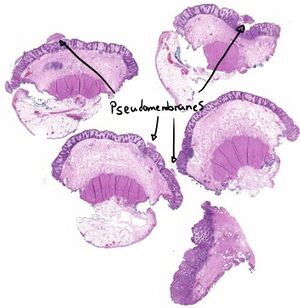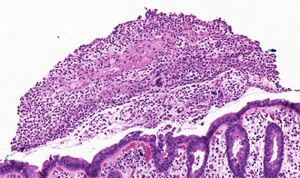23. Pseudomembranous colitis
Staining: HE


Organ: Cross section of large intestine
Description:
The lack of villi and presence of crypts shows us that this is the colon.
Many cross-sections can be seen. On some of them a small piece of tissue lies on top of the mucous membrane. This piece of tissue is comprised of neutrophils and fibrin. We cannot see any signs of necrosis.
Diagnosis: Pseudomembranosus colitis
Causes:
- Clostridium difficile
Theory:
Clostridium difficile is present even in healthy colons, but in small numbers. After an antibiotic treatment that kills the other strains of bacteria in the colon can c. difficile multiply and grow in number enough to cause this disease.
Recall that pseudomembrane formation is a type of coagulative necrosis. It’s also a type of acute fibrinous inflammation. Although necrosis is usually present in pseudomembrane formation, it cannot be seen in this particular slide.
The infection causes severe and bloody diarrhoea that may lead to dehydration.
